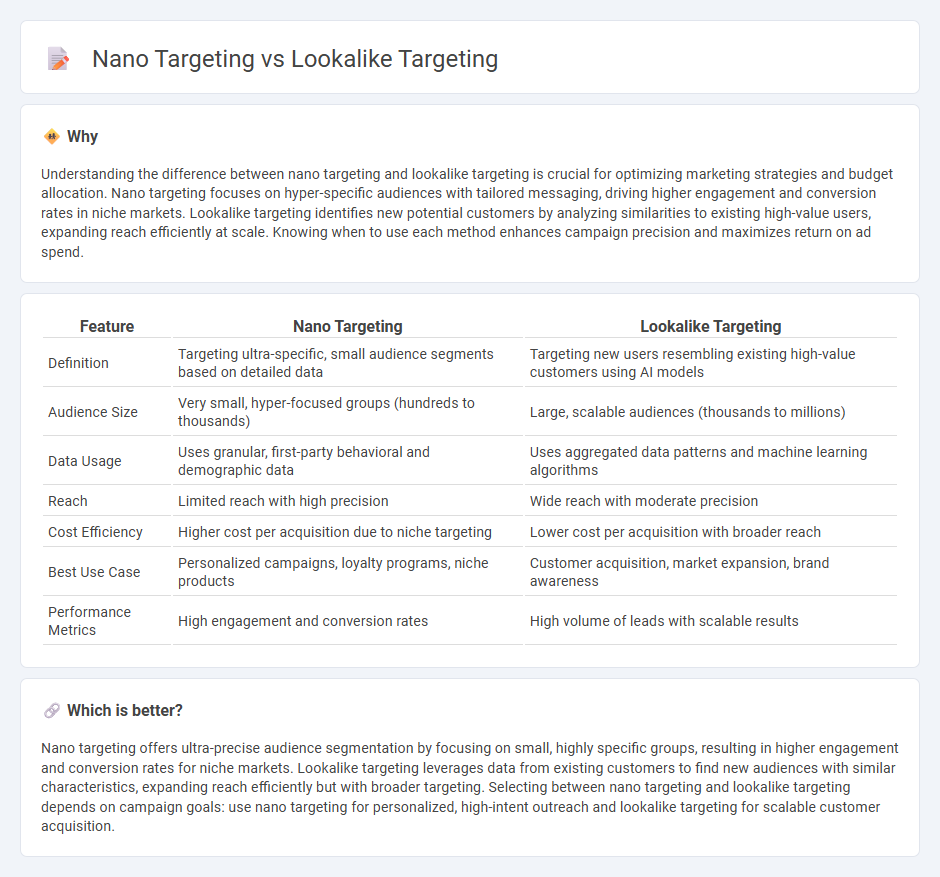
Nano targeting focuses on hyper-specific audience segments based on granular data points, enabling personalized marketing efforts with high relevance. Lookalike targeting utilizes machine learning algorithms to identify and reach new potential customers who share characteristics with an existing audience, scaling campaign reach effectively. Explore these targeting strategies to optimize your marketing ROI and engagement rates.
Why it is important
Understanding the difference between nano targeting and lookalike targeting is crucial for optimizing marketing strategies and budget allocation. Nano targeting focuses on hyper-specific audiences with tailored messaging, driving higher engagement and conversion rates in niche markets. Lookalike targeting identifies new potential customers by analyzing similarities to existing high-value users, expanding reach efficiently at scale. Knowing when to use each method enhances campaign precision and maximizes return on ad spend.
Comparison Table
| Feature | Nano Targeting | Lookalike Targeting |
|---|---|---|
| Definition | Targeting ultra-specific, small audience segments based on detailed data | Targeting new users resembling existing high-value customers using AI models |
| Audience Size | Very small, hyper-focused groups (hundreds to thousands) | Large, scalable audiences (thousands to millions) |
| Data Usage | Uses granular, first-party behavioral and demographic data | Uses aggregated data patterns and machine learning algorithms |
| Reach | Limited reach with high precision | Wide reach with moderate precision |
| Cost Efficiency | Higher cost per acquisition due to niche targeting | Lower cost per acquisition with broader reach |
| Best Use Case | Personalized campaigns, loyalty programs, niche products | Customer acquisition, market expansion, brand awareness |
| Performance Metrics | High engagement and conversion rates | High volume of leads with scalable results |
Which is better?
Nano targeting offers ultra-precise audience segmentation by focusing on small, highly specific groups, resulting in higher engagement and conversion rates for niche markets. Lookalike targeting leverages data from existing customers to find new audiences with similar characteristics, expanding reach efficiently but with broader targeting. Selecting between nano targeting and lookalike targeting depends on campaign goals: use nano targeting for personalized, high-intent outreach and lookalike targeting for scalable customer acquisition.
Connection
Nano targeting leverages highly specific audience data to create hyper-personalized marketing campaigns, while lookalike targeting uses this precise data to identify new potential customers who share similar characteristics with existing ones. Both strategies depend on granular consumer insights and advanced algorithms to optimize ad relevance and improve conversion rates. Integrating nano targeting with lookalike targeting enhances campaign precision by expanding reach without sacrificing personalization.
Key Terms
Audience Segmentation
Lookalike targeting leverages data from existing high-value customers to find new audiences with similar behaviors and traits, enhancing campaign reach and relevance. Nano targeting hones in on highly specific, narrowly defined segments based on granular data points like interests, behaviors, and demographics for precise engagement. Explore in-depth comparisons to optimize your audience segmentation strategy and maximize marketing impact.
Precision Targeting
Lookalike targeting leverages existing customer data to find audiences with similar behaviors, expanding reach efficiently but with moderate precision. Nano targeting zeroes in on extremely specific audience segments using granular data points, maximizing precision but often requiring more complex data management. Explore how precision targeting techniques can elevate your marketing strategy by diving deeper into lookalike and nano targeting methods.
Similarity Modeling
Lookalike targeting uses similarity modeling to identify new audiences that closely resemble an advertiser's existing customers based on demographic, behavioral, and interest data. Nano targeting refines this approach by analyzing micro-segments with highly specific attributes and interactions, enabling hyper-personalized marketing strategies. Explore how similarity modeling enhances precision in both lookalike and nano targeting to maximize campaign effectiveness.
Source and External Links
Lookalike Audience - A lookalike audience is a group of social network members who share characteristics with another group, used in digital advertising to reach potential customers with similar interests and behaviors.
Lookalike Audiences: What They Are and How to Build Them - Learn how to build and effectively use lookalike audiences to enhance marketing campaigns by targeting new customers who reflect your existing customer base.
Use Lookalike Segments to Grow Your Audience - Use lookalike segments in Google Ads to connect with potential new customers who share characteristics with your existing customers, helping to grow your audience.
 dowidth.com
dowidth.com